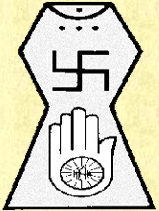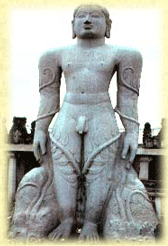 |
Jainism was started as a reform movement of the Brahmanic religious beliefs in the 6th century BC. Its founder was a widely revered saint and ascetic, Vardhamma, who was later known as Mahavir or the “great hero”. Mahavir was born in 599 BC just 50 km to the North of modern Patna near the India and Nepal border. He was about 35 years older than the Buddha and was also kind hearted towards all the living beings. His royal family was also the followers of an ascetic saint, Parvanatha, who according to Jain tradition had lived for about two hundred years. Mahavir’s life story is embellished with legends, but there is no doubt that he left his royal home for a life of the strict ascetic. He rejected the Hindu belief that the Supreme Creator had created this universe. He believed that it was infinite and eternal. Mahavir preached complete renunciation of desire and the material world for spiritual salvation. He is believed to have received enlightenment after 12 years of rigorous hardship, penance and meditation. Afterwards he travelled and preached for 30 years, and stopped only in the rainy season. He died at the age of 72 in 527 BC. |
|
His death was commemorated by a special lamp festival in the region of Bihar, which Jains claimed is the basis of the famous Deepavali festival, also known as the festival of lights. Jainism was spread only in India and in 1981 there were only 3.2 million people who were Jains. The Jain beliefs are very common among the pure forms of Hinduism, and are greatly respected and admired. Some Jain ideas, such as vegetarianism and reverence for all life, are widely recognized by Hindus as highly commendable, even by those who don’t share other Jain beliefs. The values that Jains placed on non-violence has contributed to their importance in business and commerce and they regarded all occupations except banking and commerce as violent.
From the time of the Emperor Chandragupta Maurya in the 3rd century BC, Jains enjoyed official patronage in various parts of India at different times, but it was strongest in the West and parts of the South. Some of the remarkable Jain temples can be found from Jaisalmer, in the west Rajasthan to Orissa in the East and Karnataka in the south. The 18 m high freestanding statue of Gomateshwara at Sravanabelgola near Mysore, built about 983 AD is just one outstanding example of the contribution of Jain art to India’s heritage. |
Jain Beliefs
The word Jain is derived from the word Jina that literally means “descendants of conquerors”. Jains believe that there are two fundamental principles, the living (jiva) and the non-living (ajiva). Jain monks wore very few clothes and covered their mouths to avoid any living insect accidentally entering their mouth. The main essence behind this was that they considered life as sacred, and every living entity, even the smallest insect, has within it an indestructible and immortal soul. In course of time, non-violence also became an essential element of Hinduism. Jains developed the view of ahimsa or “non-violence”, but better perhaps as “non-harming”. Ahimsa was the basis for the entire scheme of Jain values and ethics, and alternative codes of practice were defined for householders and for ascetics.
There are five vows which may be taken both by monks and by the lay people. These vows are not to harm any living being, be vegetarian and don't eat potatoes and onions, speak the truth, don't steal, give up sexual relations and practice complete chastity and give up all possessions. For the Digambara sect that possession includes the clothes. Jains also considered the manner of dying as an extremely important matter. Although suicide is deeply opposed, vows of fasting to death voluntarily may be regarded as earning merit in the proper context. Mahavir himself is believed to have died of self-starvation, near Rajgir in modern Bihar. In principle, the objectives for both lay and ascetic Jains is the same, and many lay Jains passes through the stage of being a householder, and then accept the strict practices of the monks. The essence of all the rules is to avoid intentional injury, which is the worst of all sins. Like Hindus, the Jains believe in karma, by which the evil effects of earlier deeds leave an indelible impurity on the soul. This impurity will remain through endless rebirths unless burned off by extreme penances.
|
Jain Sects
The Jains have been divided by factionalism into two main sects. The origin of these two sects can be traced back to the 4th century BC. The Svetambaras or the white clad are found mainly in the east and west India and very different from the Digambaras or the sky clad who are naked. The Digambaras were forced to move South due to the drought and famine in the Deccan region, and are now mainly found in the South India. The two sects differ chiefly on the nature of proper ascetic practices. The Svetambara monks wear white robes, and carry a staff, some wooden pots, and a woolen mop for sweeping the path in front of them, wool being the softest material available and the least likely to hurt any living thing swept away. The highest level of Digambara monks are completely naked, although the lower levels still wear a covering over their genitalia. They carry a
water pot made of a gourd, and peacock feathers to sweep the ground before they sit down.
|
 |
|
Jains believed that the spiritual journey of the soul is divided into fourteen stages, moving from bondage and ignorance to the final destruction of all karma and the complete fulfillment of the soul. The object is to prevent the addition of new karma to the soul, which comes mainly through passion and attachment to the world. Bearing the paints of the world cheerfully contributes to the destruction of karma.
Jains accepted the God in the lives of the twenty four Tirthankaras or prophets or leaders of Jainism. Their lives are recounted in the Kalpsutra, the 3rd century BC book of ritual for the Svetambaras. Mahavir is regarded as the last of these great spiritual leaders. The Tirthankaras play a similar role for Jains as the Bodhisattvas do for Mahayana Buddhists.
|
|

